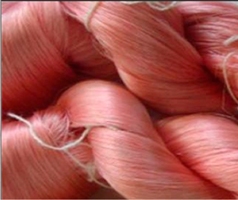Scientists have turned towards a new ‘greener’ dyeing method under which they coax colored fibers from silkworms by feeding them dyed leaves, as per a latest study conducted by the Council of Scientific and Industrial Research (CSIR) Pune and Central Sericulture Research and Training Institute (CSRTI) Mysore in India, the findings of which are published in the American Chemical Society (ACS) Sustainable Chemistry and Engineering journal.

According to a statement issued by ACS, the authors Anuya Nisal, Kanika Trivedy along with other colleagues conducted a study on ‘Uptake of Azo Dyes into Silk Glands for Production of Colored Silk Cocoons Using a Green Feeding Approach’ under which they point out that scientists are adopting the ‘greener’ dyeing method in order to reduce pollution caused due to dyeing textile fabrics.
According to the authors, in order to make the industry greener and more environmentally friendly, researchers have been developing less toxic methods, including feeding dyed leaves to silkworms so they spin colored—rather than white—cocoons.
However, so far, the technique has only been tested with one type of dye, which is too pricey for large-scale production, and hence, the team from CSIR Pune and CSRTI Mysore turned to azo dyes, which are inexpensive and account for more than half of the textile dyes that are being currently used, they added.
Under the experiment, the research team from CSIR and CSRTI sprayed mulberry leaves, the silkworm’s food of choice, with azo dyes to see which ones, when consumed, would transfer to the silk, and of the seven dyes that were tested, three were incorporated into the caterpillars’ silk, and none seemed to affect the worms’ growth.
According to the authors, researchers found that certain dye traits, such as the ability to dissolve in water, affected how well the dye worked, and these insights are extremely important in development of novel dye molecules that can be successfully used in this green method of producing colored silk fabrics.
Adopting the new method can reduce pollution which is caused by regular textile dyeing process which produces wastewater that contains potentially harmful toxins, they added.
Azo dyes are dyes that are formed by azo or amino compounds. They are usually red, brown, or yellow and are obtained from aromatic amines, and find use in clothing, personal art and crafts, and dyeing.





